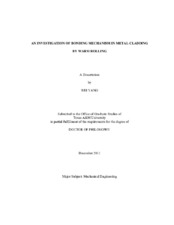| dc.contributor.advisor | Wang, Jyhwen | |
| dc.creator | Yang, Wei | |
| dc.date.accessioned | 2012-02-14T22:19:26Z | |
| dc.date.accessioned | 2012-02-16T16:17:03Z | |
| dc.date.available | 2014-01-15T07:05:29Z | |
| dc.date.created | 2011-12 | |
| dc.date.issued | 2012-02-14 | |
| dc.date.submitted | December 2011 | |
| dc.identifier.uri | https://hdl.handle.net/1969.1/ETD-TAMU-2011-12-9722 | |
| dc.description.abstract | Clad metals are extensively used for their multi-functionality and their optimal combination of quality and cost. Roll bonding is an effective and economic processing approach to making clad metals. This dissertation presents an experimental investigation of the roll cladding process as well as thermo-mechanical modeling of mechanism for roll bonding of clad metals. The objectives of this research are to investigate the bonding mechanism of dissimilar metals in a warm rolling process and to advance the knowledge of the roll cladding process.
To accomplish the objectives, aluminum 1100 sheet (Al 1100) and stainless steel 304 sheet (SST 304) are bonded by warm rolling under controlled conditions. The 180 degrees peel test is used to determine the bonding property of those clad metals. The experimental results show that the rolling thickness reduction and the entry temperature are two major factors of bonding strength. Minimum thickness reduction at a particular entry temperature is required to bond Al 1100 and SST 304. Increasing of either thickness reduction or entry temperature significantly improves the bonding strength between the two metals. X-ray microanalysis is also performed to characterize the diffusion state at the bonding interface. The diffusion coefficients of aluminum and iron are estimated through experimental method.
A thermo-mechanical model was developed to describe the rolling plastic deformation of component metal sheets and the diffusion evolution during a roll bonding process of dissimilar metals. The effect of various rolling conditions on the contact area ratio was quantitatively discussed. Finite element simulation of 2-D diffusion under the rolling created boundary conditions was performed. The peel strength during the diffusion evolution was predicted by the integrated roll bonding model. The modeling predictions correspond to the experimental results well. The correspondence validates the effectiveness of the thermo-mechanical roll bonding model.
Based on experimental observation, this research presents a bonding mechanism for the roll cladding process of dissimilar metals. The roll bonding model can help optimize rolling parameters for varying bonding strength depending on the demands of the application. It can also provide insights into design and analysis of rolling bonding process of other groups of dissimilar metal sheets. | en |
| dc.format.mimetype | application/pdf | |
| dc.language.iso | en_US | |
| dc.subject | Clad Metals | en |
| dc.subject | Roll Bonding | en |
| dc.subject | Oxide Film Fracture | en |
| dc.subject | Metal Extrusion | en |
| dc.subject | Diffusion | en |
| dc.title | An Investigation of Bonding Mechanism in Metal Cladding by Warm Rolling | en |
| dc.type | Thesis | en |
| thesis.degree.department | Mechanical Engineering | en |
| thesis.degree.discipline | Mechanical Engineering | en |
| thesis.degree.grantor | Texas A&M University | en |
| thesis.degree.name | Doctor of Philosophy | en |
| thesis.degree.level | Doctoral | en |
| dc.contributor.committeeMember | Benzerga, Amine | |
| dc.contributor.committeeMember | Hartwig, Karl T. | |
| dc.contributor.committeeMember | Karaman, Ibrahim | |
| dc.type.genre | thesis | en |
| dc.type.material | text | en |
| local.embargo.terms | 2014-01-15 | |


